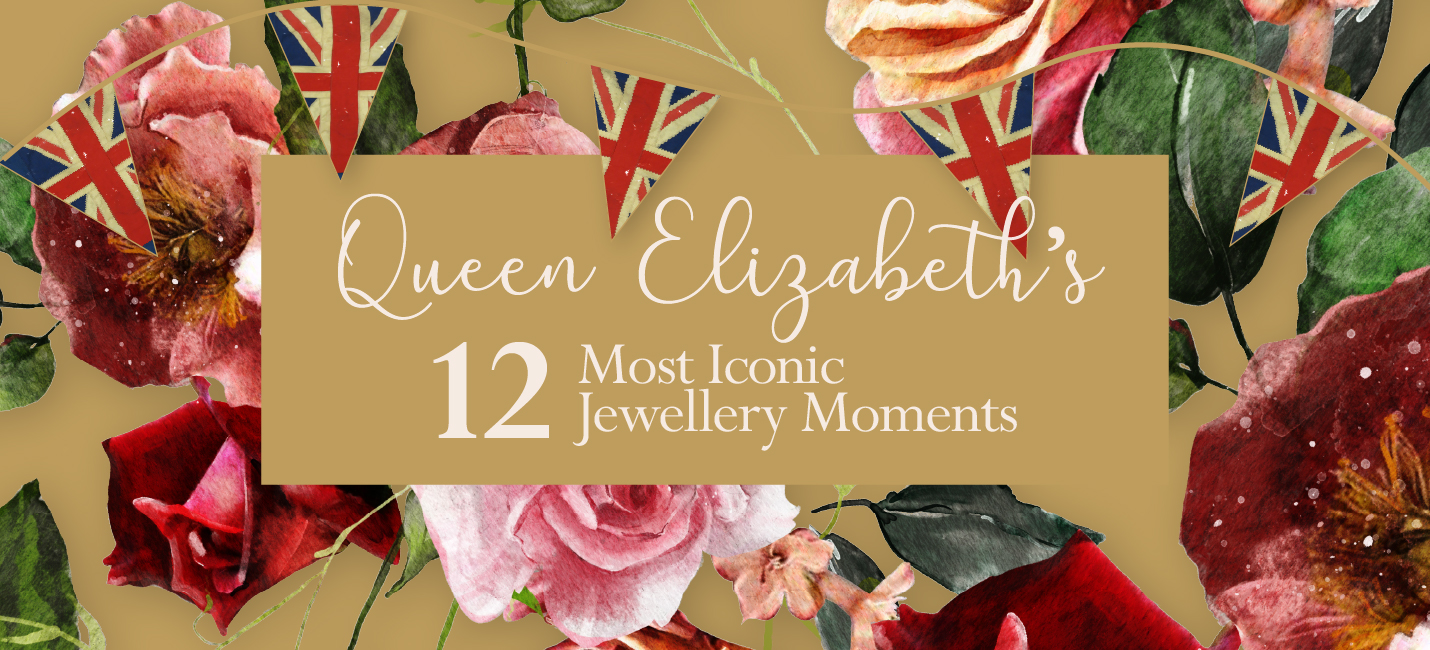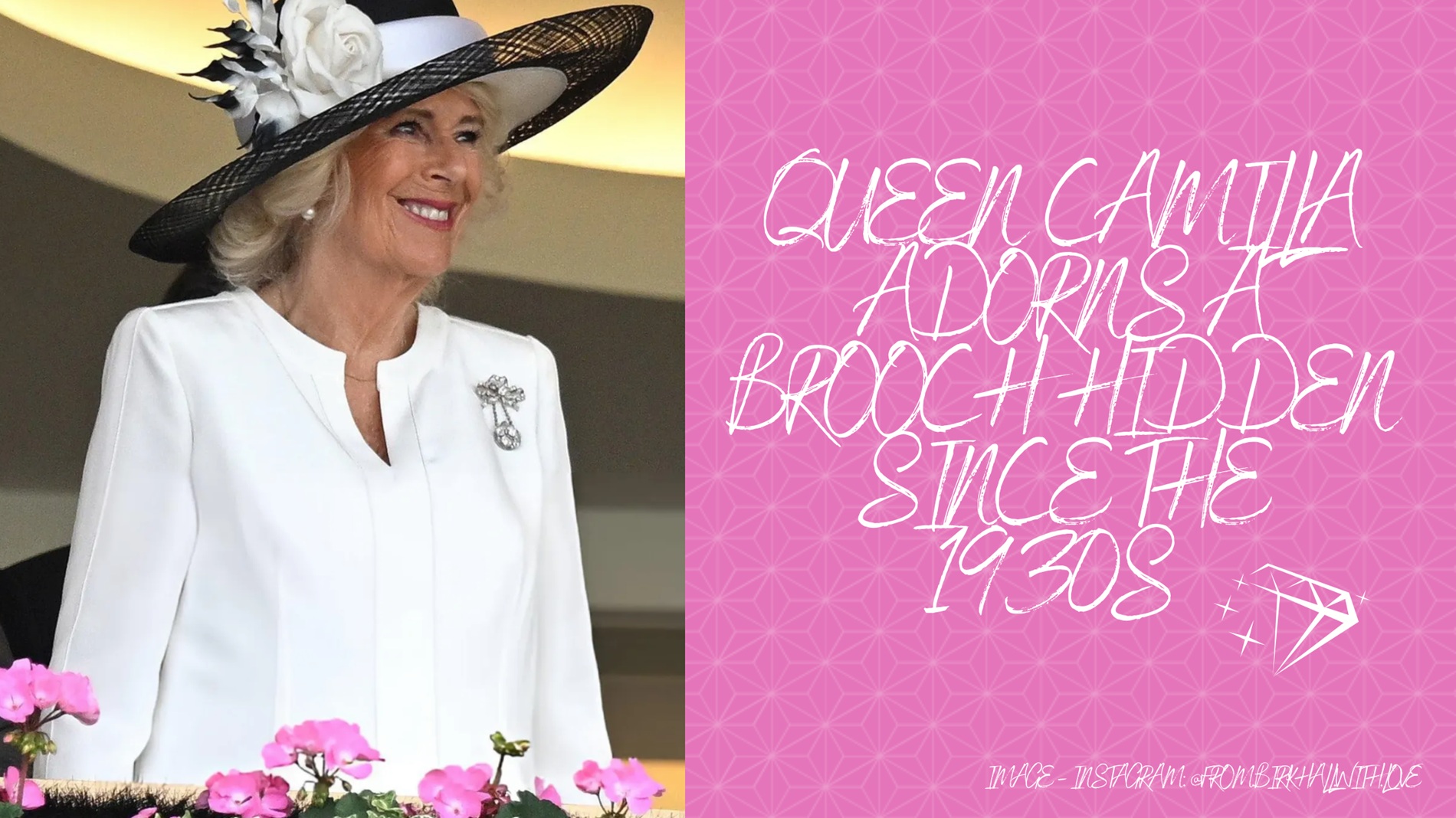From huge, flawless diamonds to magnificent rubies, sapphires, and pearls, Queen Elizabeth’s jewellery collection features some of the world’s most eye-catching jewels.
To celebrate the Queen’s Platinum Jubilee, experts at Steven Stone have taken a look into her collection to reveal everything you need to know about her most iconic pieces – from the estimated values to the heart-warming stories behind them.
Diamond Diadem
Estimated Value: £6,000,000
When did she wear it: 1952: Royal Portrait 1952: First state opening of parliament 1953: On the way to her coronation 2010: Returning to Buckingham Palace after the state opening of parliament
The story behind it: Instantly recognisable as the headpiece worn by the Queen on postage stamps from 1953-1971, the diamond diadem is probably the most well recognised of all her pieces of jewellery and will be on view in the State Rooms of Buckingham Palace during the Royal Collection’s summer opening, as part of an exhibition exploring the Queen’s accession.
Created for the coronation of King George IV in 1821, the diamond diadem consists of a band of two rows of pearls, either side of a row of diamonds, with 1,333 brilliant-cut diamonds making up the design. Queen Elizabeth II is not the only monarch to have worn it when modelling for postage stamps, either; her great, great-grandmother Queen Victoria was also featured wearing it on the Penny Black stamp. The famous Dorothy Wilding portrait of Queen Elizabeth wearing the diadem was taken just weeks into her reign.
Taking a close look, our jewellery expert, Maxwell Stone said: “Dating back to the coronation of King George IV in the 1800’s, the famous diamond diadem is beautifully set with Edwardian cut stones and a striking four-carat fancy yellow diamond. Passed through the monarchy to Queen Alexandra, Queen Mary, Queen Elizabeth I and now Queen Elizabeth II – modelled on postage stamps by the latter two royals – it has huge historic value. With this in mind, I’d estimate its worth be around £6,000,000.”
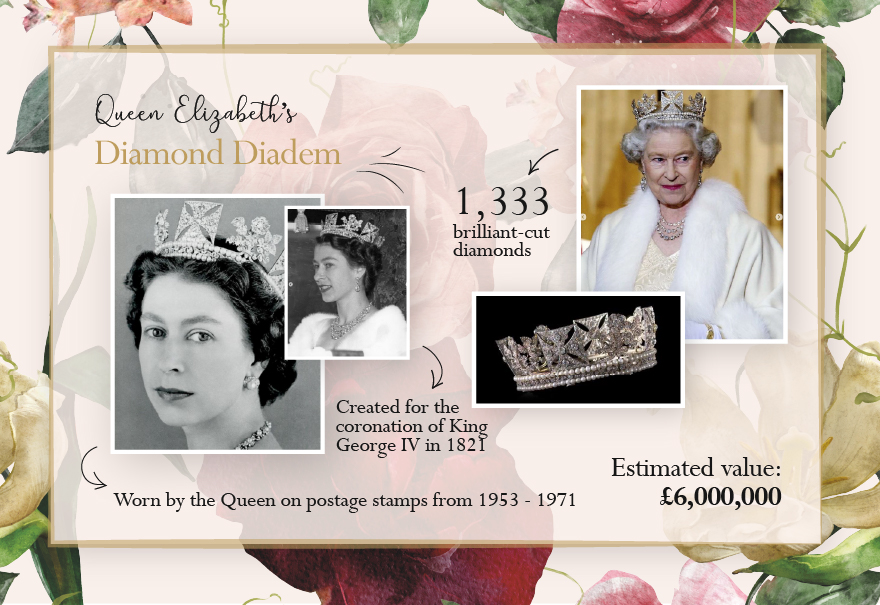
Flame-Lily Brooch
Estimated value: £20,000
When did she wear it: 1952: Commonwealth tour 2011: Christmas speech 2017: Royal Ascot
The story behind it: The Flame-Lily brooch is a piece of jewellery that’s always close to Queen Elizabeth II’s heart. It has a heart-warming story, which is probably why it’s one of her most frequently worn pieces of jewellery.
Taking the form of a flame lily – the national flower of Zimbabwe – the brooch was given to Princess Elizabeth as a 21st birthday present by school children of the country in 1947.
In 1952, as she was set to embark on her Commonwealth tour, she wore the brooch on her return to London from Kenya following the death of her father King George VI, and on several other occasions near the time of her father’s death.
Over the years, the brooch has remained a firm favourite, with the Queen wearing it on many grand occasions.
Maxwell Stone said: “The story behind the Queen’s beautiful diamond and platinum flame-lily brooch is an incredibly touching one, which is probably why it’s one of her most frequently worn pieces of jewellery. Though she’s worn hundreds of brooches across her reign, this was the first that she wore as monarch so it’s incredibly sentimental. I’d estimate its value to be £20,000.”

Cullinan III and IV brooch
Estimated Value: £50,000,000
When did she wear it: 1958: State visit to the Netherlands 2012: Diamond Jubilee
The story behind it: The Cullinan III and IV brooch is made of the third and fourth largest stones cut from the famous Cullinan Diamond. The jaw dropping 3,106 carat uncut diamond was presented to King Edward VII in 1907, and it was cut by Joseph Asscher in Amsterdam the next year. Whilst the two largest stones cut from the diamond are set in the Sovereign’s Scepter and the Imperial State Crown, the pear-shaped 94.4 carat Cullinan III and the square-cut 63 carat Cullinan IV were presented to Queen Mary by the Government in 1910.
In 1911, she commissioned Carrington and Co. to make a platinum brooch setting for the stones.
In 1953, Queen Elizabeth inherited the brooch, however she doesn’t wear it very often. In 1959, she loaned the brooch to London’s Ageless Diamond exhibition, and in 2012 it was part of another exhibition at Buckingham Palace to celebrate the Queen’s Diamond Jubilee.
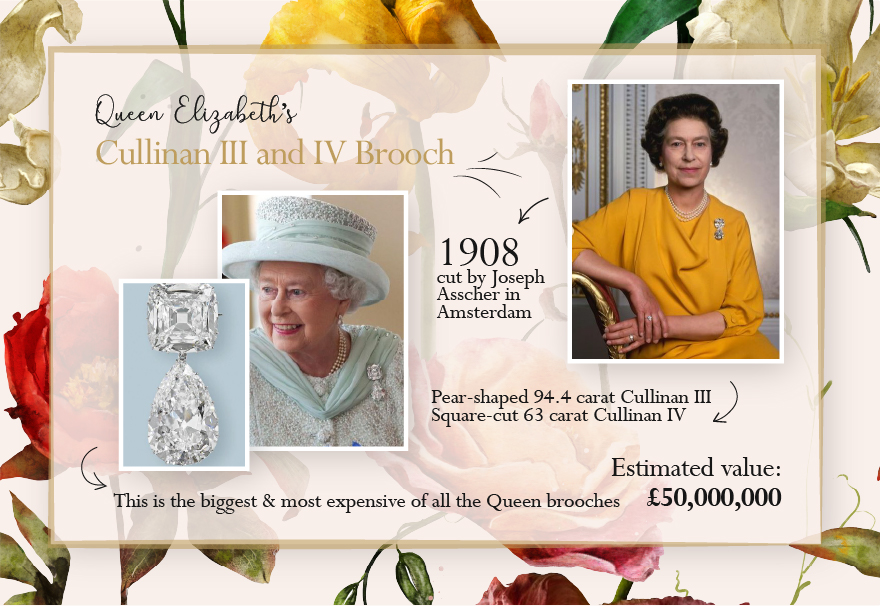
Scarab brooch
Estimated value: £250,000
When did she wear it? 1966: Bournemouth Town Hall 2002: Golden Jubilee tour, Falmouth 2007: Cancer Research Institute, Cambridge 2007: National Armed Forces Memorial, Lichfield 2007: Christmas Broadcast 2008: Slovenia 2011: Merseyside 2015: Gloucestershire 2017: Official platinum anniversary portrait 2022: Prince Philip’s memorial service
The story behind it: The Queen has a huge collection of exquisite brooches but her scarab brooch stands out by a mile. Gifted to her by Prince Philip in 1966, it’s design is breathtaking, unique, and it clearly holds so much sentimental value.
Maxwell Stone said: “The Scarab brooch features over 20cts of cabochon rubies, which are often associated to love, passion, courage, and raw emotion. The stones are placed on a magnificent yellow gold setting, which makes the piece one of a kind. A brooch like this has a value of around £250,000.”
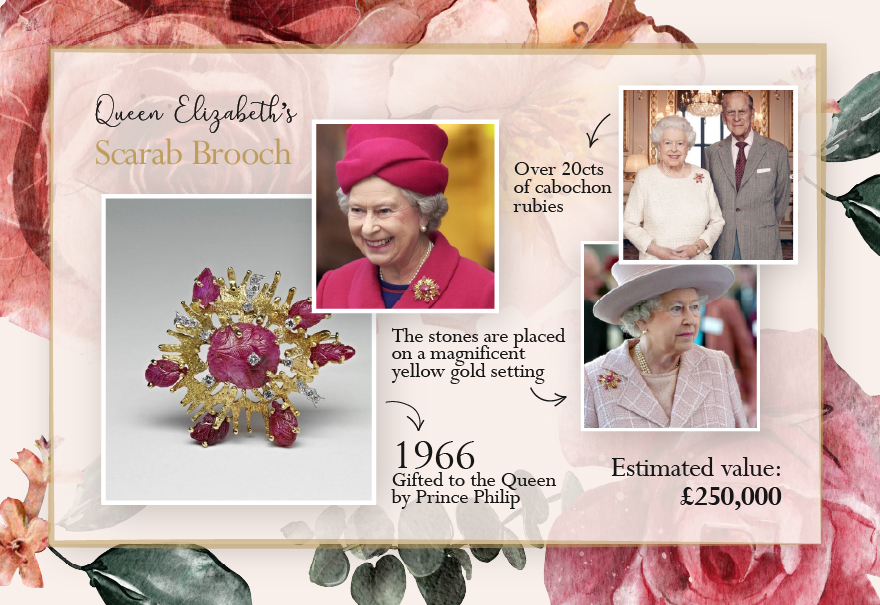
Nizam of Hyderabad necklace
Estimated value: £65,000,000
When did she wear it? 1952 and 1953: Royal Variety Performance 1956: Order of Amaranth Ball, Sweden 2002: Queen’s Golden Jubilee Dinner at Windsor Castle
The story behind it: This incredible necklace was a wedding gift to Princess Elizabeth from the Nizam of Hyderabad, who was known at the time as one of the wealthiest people in the world.
It is believed that the Nizam of Hyderabad requested that Cartier allow Queen Elizabeth II to choose anything she fancied from their impressive collection of jewels. The Queen opted for a tiara with three detachable flower brooches – and what we now know as the Nizam of Hyderabad Necklace.
The necklace has been one of the Queen’s most talked about pieces of jewellery in history, thanks to the incredible diamonds featured in the piece. The necklace, which was made by Cartier in 1935, is extremely intricate featuring over 50 diamonds nestled in an abstract floral design. Our experts believe it is has a value of around £60,000,000 to £65,000,000.
Queen Elizabeth isn’t the only royal to wear this stunning jewel either, as Kate Middleton famously paired the Nizam’s Cartier Necklace with Queen Mary’s Lover’s Knot Tiara for the Diplomatic Reception at Buckingham Palace in 2019.

Three stand pearl necklace
Estimated value: £1,000,000
When did she wear it? February 2022: 70th Anniversary Celebration
The story behind it: Pearls have always had a connection with royalty, however Queen Elizabeth is especially known for her love of this radiant gemstone, wearing a pearl necklace for countless events and occasions. The Queen has an extensive collection of pearl necklaces, some with just one strand and others with three or four, however on most occasions, she wears a three-strand pearl necklace – and there’s a reason why.
Thanks to a tradition started by Queen Victoria, Queen Elizabeth is reported to have fallen in love with pearl jewellery when she was a child – Royal experts report that Queen Victoria gave each of her daughters and granddaughters a single pearl on their birthday as they grew up, so that by the time they reached the age of 18, they would have enough pearls for a necklace.
Queen Elizabeth’s parents continued the royal tradition, giving her a chain onto which they added two pearls per birthday. The Queen also received a complete pearl necklace from her father, King George VI for her coronation in 1937.
In February 2022, to kick off her 70th anniversary celebrations, Queen Elizabeth wore one of her most adorned three-strand pearl necklaces. Maxwell Stone said: “One single natural pearl is worth around £3,000, and as the Queen has a three-strand necklace, this could be worth anywhere from £600,000 to £1,000,000.”
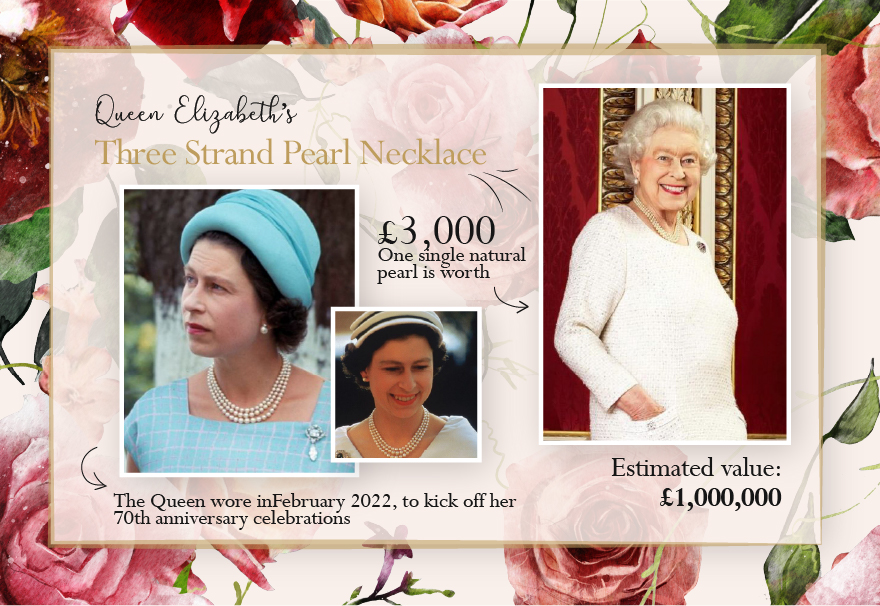
Burmese ruby tiara
Estimated value: £7,000,000
When did she wear it: 2019: State Banquet with Donald Trump
The story behind it: Queen Elizabeth has a lot of tiaras in the royal collection, but one that always sticks in our minds is the Burmese ruby tiara. In 1973, she commissioned House of Garrard to create the Burmese Ruby Tiara using the gems she received as a wedding present from the people of Burma.
In total, there were 96 rubies which were combined with a selection of diamonds to create the new tiara. However, the Queen had to dismantle the Nizam of Hyderabad tiara, taking some extra diamonds from it.
Interestingly, there’s a good reason why this tiara features a specific number of rubies, and why the people of Burma gave Queen Elizabeth a specific 96 stones – rubies are believed to have healing qualities, and Burmese people believe that there are 96 illnesses which could hit one’s body, so the 96 rubies were a gesture of protection for the Queen and her health.
This tiara has caused quite a bit of controversy over the years, most notably when Donald Trump attended the State Banquet in 2019. Because of the special meaning the rubies hold, it’s been rumoured that the Queen was sending subliminal messages to the former President by wearing that particular tiara. While it’s impossible to know if this is the case, the tiara received a lot of attention and ultimately became one of the Queen’s most talked about pieces.
Maxwell Stone said: “The beautiful tiara is not only sentimental, but it’s also very valuable, as Burmese rubies are extremely precious and rare. The tiara’s jewels are set in a series of rose motifs inspired by the Tudor Rose, which pay homage to British Heritage. Considering the number of rubies and diamonds featured in this piece, we estimate it has a staggering value of around £7,000,000.”

King George VI Sapphire Suite
Estimated value: £8,000,000
When did she wear it: 1951: Midnight Matinee 1953: Premiere of the film Rob Roy 1990: Royal Canada Tour 1994: D-Day invasion anniversary banquet 2002: Golden Jubilee celebrations at the Ritz 2006: 80th birthday party at the Ritz 2019: Canadian Royal Portrait
The story behind it: The George VI Sapphires are undoubtedly among Queen Elizabeth’s most meaningful jewels. The demi-parure, which consists of a Victorian-era necklace and earrings, was a wedding gift from her father in 1947. A few years later, the Queen refashioned the necklace, shortening it and removing the largest sapphire stone to turn into a pendant. Sometime during the ’60s, she also commissioned a matching bracelet to accompany the set.
Queen Elizabeth most recently wore the meaningful jewellery suite for her official Canadian royal portrait in 2019. In 1990, the Queen took the whole suite with her for a royal tour of Canada—making it a particularly meaningful choice for the portrait.
The incredible sapphire and diamond cluster line necklace originally featured 18 sapphires, sat on a gradient, ranging from 8 to 30cts, before it was redesigned in 1952. These huge sapphires are surrounded by a halo of diamonds and linked together by additional single stone diamonds, which are between 0.8ct and 1.5ct.
When Queen Elizabeth altered the necklace, she removed four of the sapphire clusters from the back and remodelled and reset one of larger stones from the front, to create a beautiful pendant for the necklace.
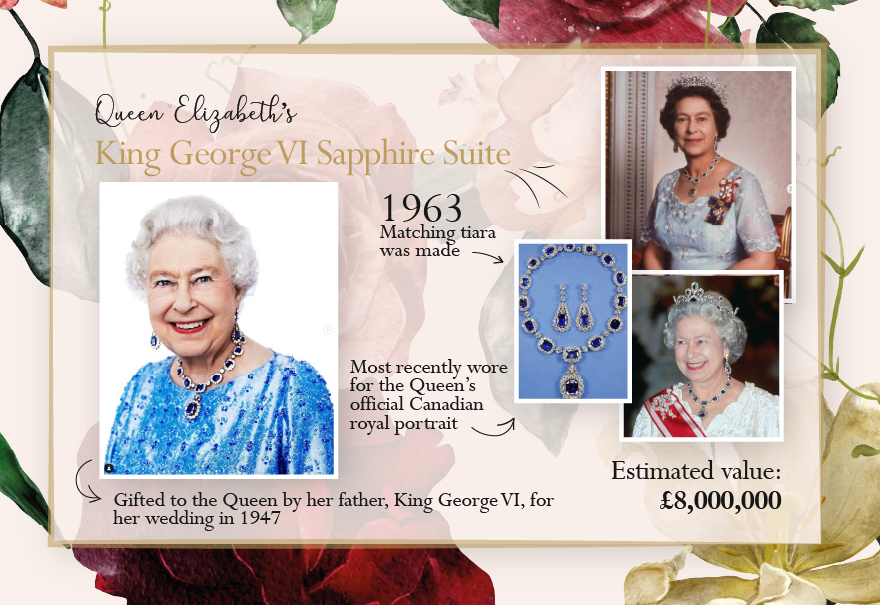
Prince Albert brooch
Estimated value: £8,000,000
When did she wear it: 1971: Derby Day at Royal Epsom 1982: Prince William’s christening 1993: The Derby Races 1999: The Overseas Service Pensioners Joint Commemoration Service at Westminster Abbey 2013: Royal Ascot 2015:State visit to Germany 2017: Reception for female permanent secretaries at The Queen’s Gallery 2019: Christmas Broadcast
The story behind it: One of the Queen’s most special jewels is the Prince Albert brooch, which dates back to the 1800s. In 1840, Prince Albert secretly commissioned Garrards to make a sapphire and diamond brooch for his bride to be, Victoria. He gave her the brooch on the night of their wedding, and it was so adored by Victoria, that she wore it frequently. After being passed down to Queen Elizabeth II, it became a staple accessory, featuring in many of her most iconic outfits.
Not only that, but the brooch is said to have inspired the design for Kate Middleton’s engagement ring, which was originally given to Princess Diana from Prince Charles.
According to Maxwell Stone, “The brooch contains a large oval or cushion shaped sapphire, which is at least 40cts. The breath-taking gem is also surrounded by 12 large diamonds, which look to be around 12cts.
Due to the clarity and intense colour of the sapphire it was possible sourced from Burma. If it was to be sold today, it would be worth around £8,000,000, thanks to its historic legacy.”
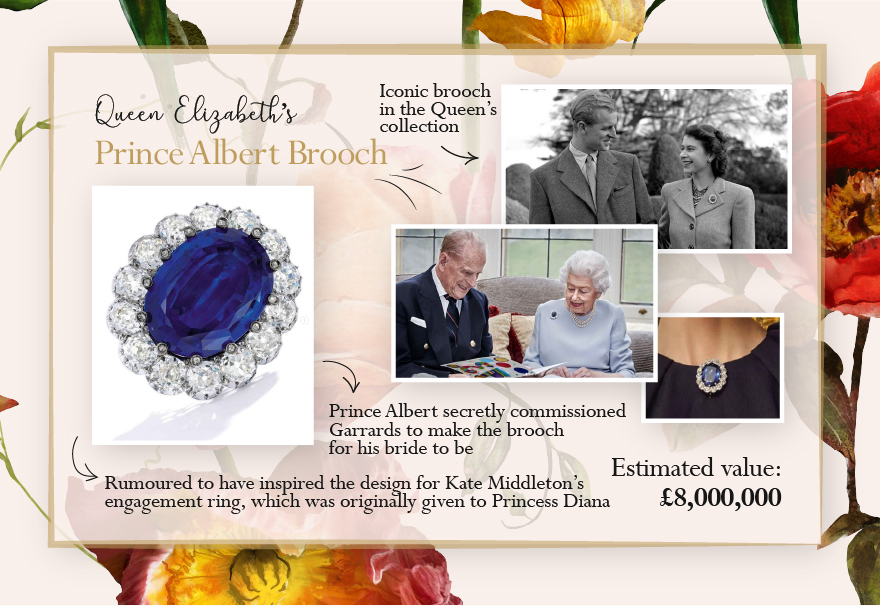
Diamond fringe tiara
Estimated value: £5,000,000
When did she wear it: 1947: On her wedding day
The story behind it: Commissioned by Queen Mary in 1919, the British royal family’s beloved diamond fringe tiara was originally a fringe necklace that was a wedding day gift from Queen Victoria, which she often wore in her hair.
However, Queen Mary was fond of customising her jewellery pieces, so 26 years after her wedding day in 1893 she asked royal jeweller Garrard to make it into a kokoshnik-style piece, consisting of 47 graduated brilliant and rose-set tapering bars, separated by 46 narrower spikes, which could still be removed to make a necklace.
It was later given to Queen Elizabeth I as a wedding gift and was often worn by Princess Margaret, before the tiara was returned to Elizabeth II.
The Queen Mother also loaned the tiara to her daughter Queen Elizabeth II to wear at her wedding in 1947. According to the Court Jeweller, there’s a well-known story about the tiara, which involved a huge mishap. It’s believed that when the tiara was placed on the bride’s head, it snapped – and had to be repaired by jewellers Garrard before she could walk down the aisle.
The second Windsor bride wear the tiara was Princess Anne, who wore it to her wedding to Mark Phillips in 1973. The tiara also featured on Queen Elizabeth’s Barbie doll, designed by Matell to celebrate the upcoming Jubilee, which emphasises just how iconic this piece of jewellery is.
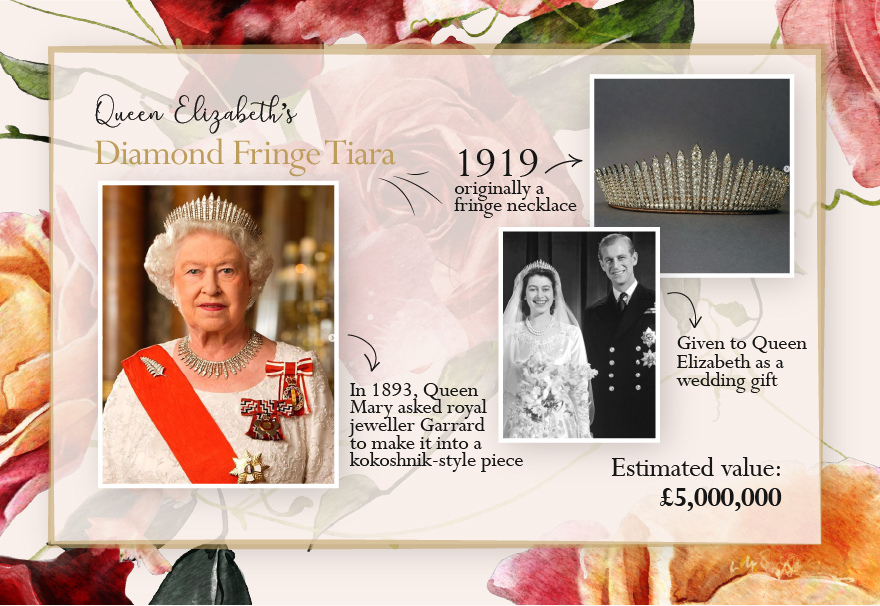
Delhi Durbar necklace
Estimated value: £3,000,000
When did she wear it: 1956: Royal Portrait 1961: State visit to Tehran 1963: State Library of New South Wales, Australia 1996: State visit to Thailand 2014: State Dinner for the President of the Republic of Ireland at Windsor Castle 2015: Commonwealth Heads of Government of Government meeting in Malta
The story behind it: Queen Elizabeth II has worn the Delhi Durbar necklace on many important state occasions throughout the years, and it’s easy to see why. As well as being one of the most magnificent necklaces in her collection, it also has a scandalous family history.
According to Royal Central, in 1817, not long after George III had marked his Golden Jubilee, his granddaughter, Princess Charlotte of Wales, sadly passed away in childbirth. Charlotte had been second in line to the throne and George III had no other grandchildren at that time.
His heir was his dissolute eldest son, then Prince Regent, whose marriage was in tatters. The remaining unmarried sons of George III headed off to find wives. In 1818, the king’s seventh son, Prince Adolphus, Duke of Cambridge married the young German princess, Augusta of Hesse-Kassel. At that time, the princess bought raffle tickets for a charity lottery, winning 40 cabochon emeralds, some of which were made into a necklace. The others remained unset until they eventually passed to her daughter, Mary Adelaide, mother of Queen Mary, who bequeathed the gems to her son, Prince Francis.
When Prince Francis died in 1910, he left the emeralds and all of his jewels to his mistress, the Countess of Kilomrey. To try and keep the scandal low-profile, his sister Queen Mary bought the jewels from the Countess, commissioning Garrard to create a necklace with the jewels.
Along with most of her collection, the necklace was inherited by Queen Elizabeth II in 1953. Since then, Her Majesty has worn it on numerous occasions and is typically seen wearing it with other emerald jewels – specifically the Grand Duchess Vladimir Tiara, which can also be set with emeralds.
Taking a look at the necklace, Maxwell Stone said: “Set in platinum and gold, the dehli durbar necklace consists of nine of the celebrated Cambridge emeralds that look to be upwards of 20 carats, and six large diamonds that look to be upwards of 10 carat. Impressively, it also features a diamond cut from the Cullinan diamond, which is the largest diamond ever found. I’d estimate it to be worth a staggering £3,000,000.”

Engagement ring
Estimated value: £207,000
The story behind it: Queen Elizabeth II’s engagement ring from Prince Philip has a special story, as the diamonds used to create the ring came from a tiara belonging to his mother – Princess Alice of Battenberg. Prince Philip designed the square-cut diamond engagement ring with jewellers, Philip Antrobus Ltd.
The ring is set with eleven diamonds, including five smaller stones set on each shoulder.
Using diamonds from his mother’s tiara may have been a way to save money, as well being as a sentimental gesture, as whilst Prince Philip was born a Greek prince, it seems his family were not extremely wealthy. The Queen’s ring is made from a nugget of Welsh gold from the Clogau St David’s mine, near Dolgellau.
The same nugget has been used to make Princess Anne, Princess Diana and Kate Middleton’s rings.
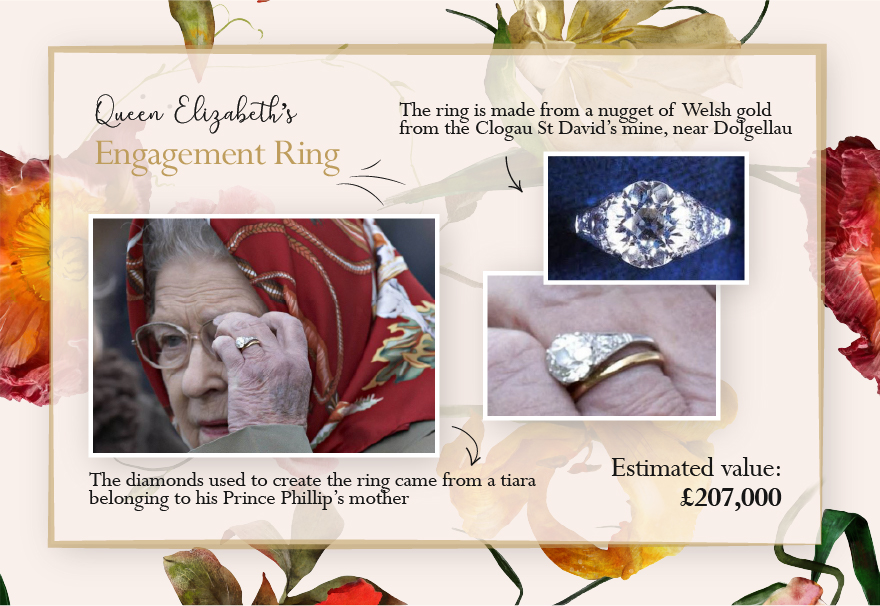
If you’re looking for jewellery to rival royalty, our team can design bespoke creations, tailored to you. From engagement rings and wedding rings to necklaces and pendants, your options are endless.
Follow us on our socials
Pop over to our social platforms to keep up to date with Steven Stone’s latest jewellery content and news.
